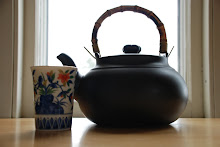
Having never been an insomniac for any long stretches of time, I was not anxious to become one whose dreams were punctuated by images of a lurid-colored flower. With only brief snatches of sleep the night before in which a carnivorous piece of flora -a hipper looking Audrey Junior- played a starring role, I decided a change was in order: I would give up drinking caffeinated teas in the late evenings. After indulging in many cups of green tea the previous evening, that night saw me wide-eyed, tossing to and fro in bed. My mind, surging unnaturally with activity, was racing like a whippet as the first rays of light peeked through the bedroom curtains. Realizing it was time to get up, I stumbled out of bed, flicked off the alarm, and got ready for work. The sleep deprivation affected me curiously; I felt unexpectedly alert and actually did not feel sleepy once the initial grogginess wore off. But this state was deceptive as I found myself making trivial mistakes unaccountably. So yes, it was time to make a self-intervention.

I tried to look upon this as an opportunity to enlarge my repertory of herbal teas. I counted among my tea collection a meager cache of tisanes: a rooibos, more teabags than I would like to admit to having, and one of my favorites,
Rishi's tangerine ginger.
This tea's aroma, redolent of citrus essence, invoked an Andalusian orchard filled with ripened oranges on a sun-drenched day. The tisane brewed a deep berry-red liquor whose taste was tangy, sweet, and gingery, all meshing together wonderfully. I decided to pair this tea with a soba dish, one that has become a staple in our household in the last several years.

The nutty soba noodles were drizzled with a soy-based sauce in which a smattering of grated ginger and garlic along with dry sherry have been added. Generous amounts of fresh spinach and handfuls of assorted mushrooms, stir-fried with cubes of tofu, topped the noodles and made this dish easily a meal on its own.

The silky tofu ( I find Trader Joe's a particularly good source of fresh-tasting tofu), now suffused with the savory sauce, made a pleasing textural contrast with the nuttiness of the soba as well as that of the mushrooms. I sipped the tea and found that its gingery flavor met its complement in the noodle dish. As I gazed at the ruby-red liquor of my tea, I lazily wondered why I watched so many Roger Corman movies as a kid.
Here is the recipe for the noodle dish, tweaked a little from its original -I added mushrooms and decreased the amount of oil used for stir-frying, the latter to make it more "heart-healthy":
Teriyaki Soba Noodles with Tofu and Stir-fried Spinach and Mushrooms
(adapted from the August 2002 issue of Vegetarian Times)
2 large servings or 4 smaller servings
Ingredients:
1/2 lb of dried soba noodles
3 Tbs. sesame seeds, toasted
1 lb. firm tofu, drained and cubed
4 cups of firmly packed spinach, rinsed and shredded
handfuls of assorted mushrooms ( I like shiitake and porcini)
1 1/2 Tbs. canola or olive oil
Teriyaki Dressing:
1/2 cup low-sodium soy sauce
2 Tbs. sherry
1/8 cup granulated sugar
1 1/2 Tbs. grated fresh ginger
2 tsp. minced garlic
1. Bring pot of water to rolling boil and cook soba noodles according to package directions. Rinse under cold water and drain completely.
2. Toast sesame seeds until golden in ungreased wok.
3. Heat 1 1/2 Tbs. oil over medium heat in wok and stir-fry cubed tofu for 3 minutes. Add mushrooms and spinach and stir-fry for an additional 2-3 minutes.
4. Divide noodles into soup bowls. Top each portion with tofu, spinach, and mushrooms. Add dressing, toss, and garnish with sesame seeds.





































